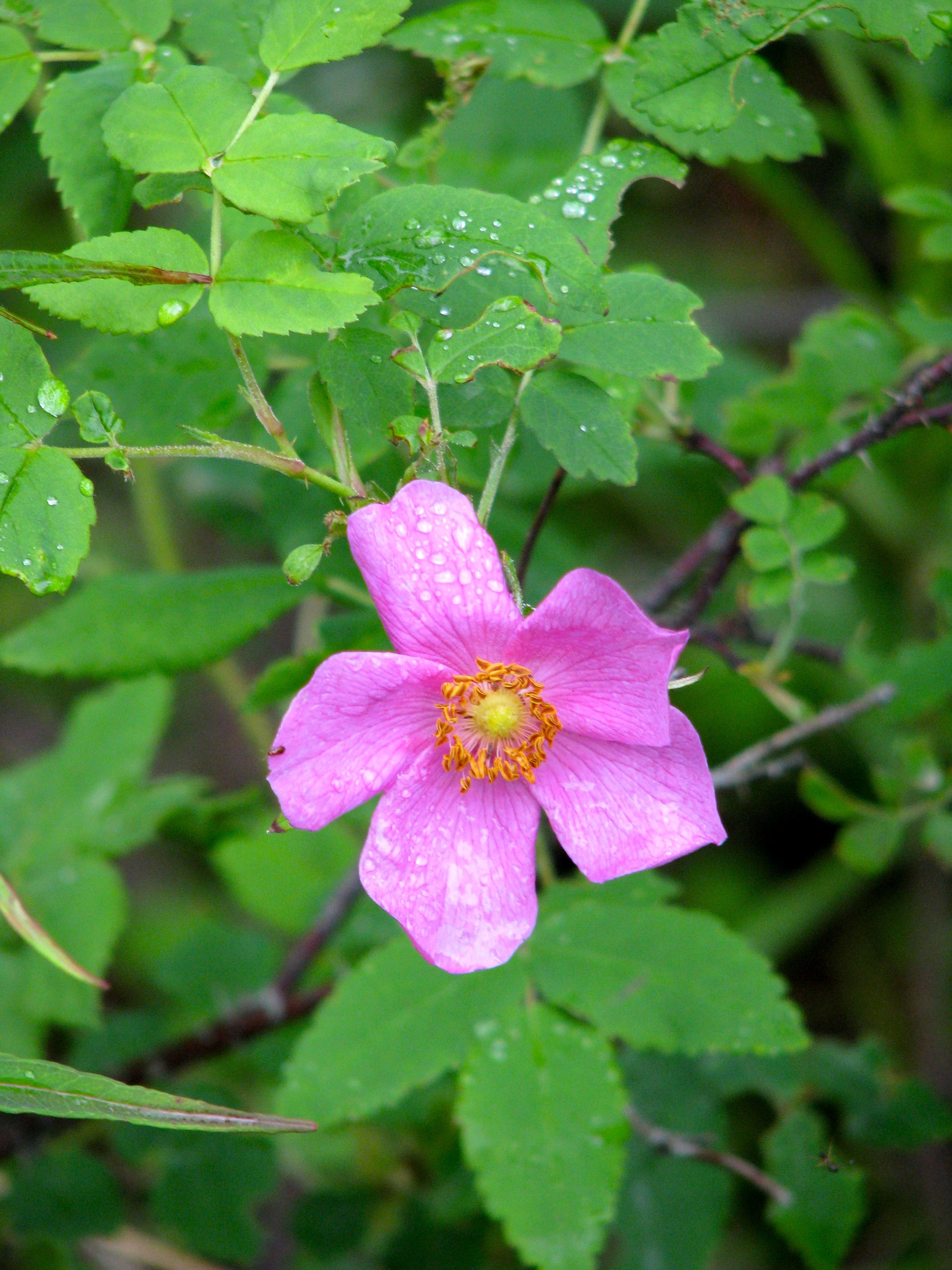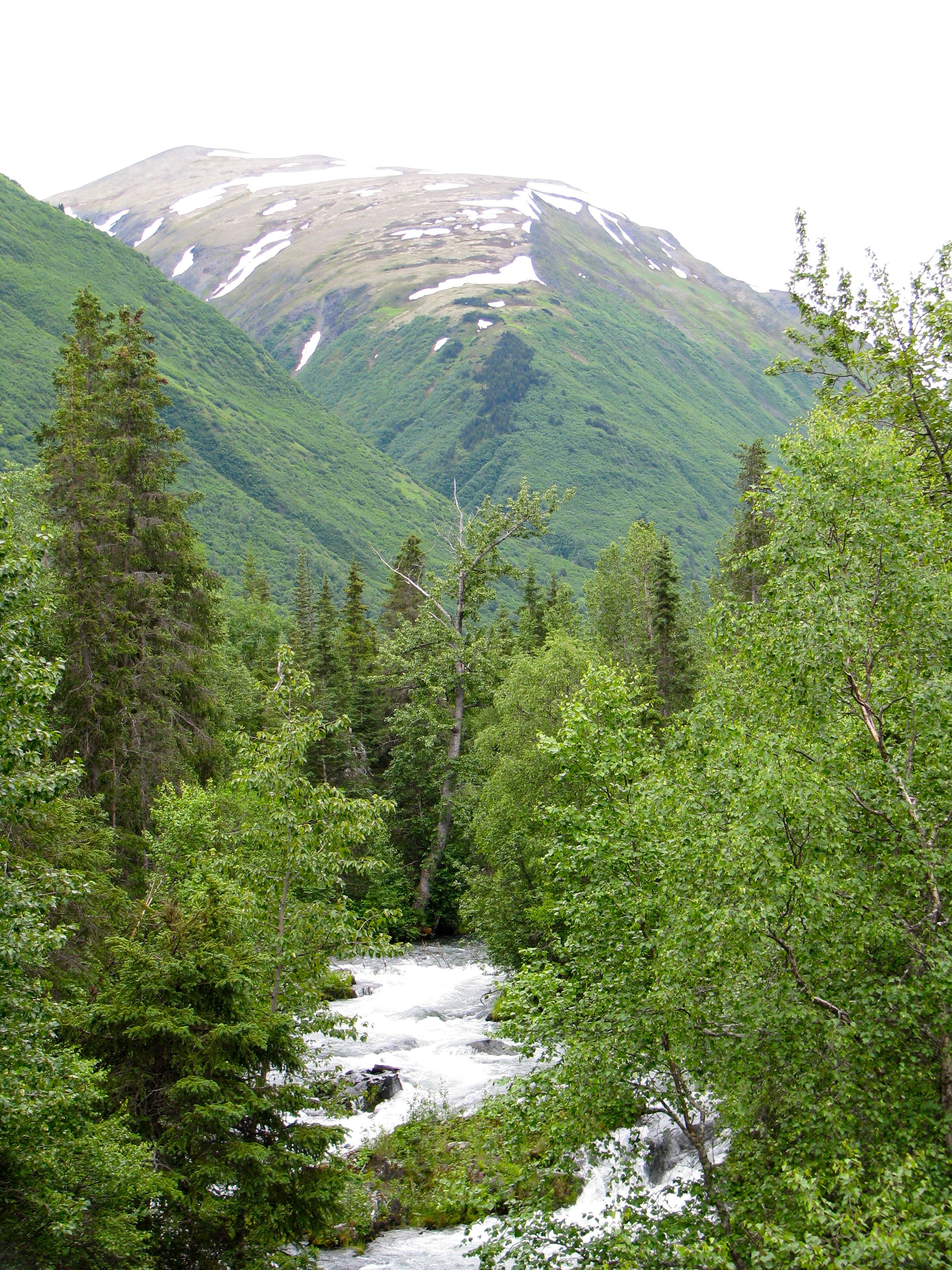Chugach National Forest, Cooper Landing, Alaska (July 2010)
Right at the middle of Alaska’s Kenai Peninsula, just off Sterling Highway west of Cooper Landing, the Russian River Falls put on a spectacular show for those who follow a gentle trail through the woods (map).
It’s not amazing because of any great vertical drops. No, the Russian River crashes down a series of manageable ledges here. Neither is it all that remarkable from a scenic perspective; it’s a pretty sight but so are hundreds of other competing waterfalls throughout the Kenai. What makes it so special, so endearing are the massive runs of Sockeye salmon that power their way upstream through the thick of these roiling waters each summer, on the way to their ancestral spawning grounds.
It’s not too difficult to experience this in person. The falls are protected within the boundaries of the Chugach National Forest, the most northerly of national forests in the United States. Several campgrounds operated by the Forest Service exist within this domain, including one along the Russian River. That’s the one that provides access to these falls.
Directions
Take the Sterling Highway to Mile 52 and then follow the turnoff for the Russian River Campground. Check-in with the ranger manning the entrance and proceed for about a mile to the Russian River trailhead parking lot on the left. It was full when we arrived but there’s a small overflow lot just a bit past it on the right side of the road, where we easily found a spot. We found one benefit to the overflow lot: it shortens the length of the trail a bit, and that’s a nice feature with a couple of small kids in tow.
Hiking to the Russian River Falls

The portion of the Russian River Trail leading to the falls is about 2.5 miles, well-maintained, plenty wide, and includes only gentle elevation changes. It’s hiking-lite; more of a stroll, really. The trail starts in a woodland setting and later enters into a more open area where sunlight streams through, an artifact of the 1969 Russian River Fire that burned more that 2,500 acres. There is a small memorial along the trail here, dedicated by the Forest Service to a firefighter who died during that conflagration. The trail continues back into the woods until it splits. Hikers can cross the wooden bridge and head toward the Russian Lakes or continue onward on the spur leading towards the falls.
Beware of Bears
Hikers are reminded repeatedly to be on the lookout for bears. Black Bears and Grizzly Bears both live here in abundance. Many people hike the trail with noisemakers, such as sleigh bells, and with pepper spray. We had two human noisemakers as part of our group, two loud boys with a constant stream of commentary as we hiked along. I’m sure bears were in the area but I’m also sure they heard us coming from miles away and gave us a wide berth. There was also a continuous flow of hikers in both directions on this fine summer weekend, and I’m sure that contributed too.
The trail sloped gently downhill after the split and we soon found ourselves within earshot of the unmistakable sound of rushing water.
The Falls

The Russian River carves a tight path as it fills the gap that forms its eponymous falls. The Forest Service provides two wooden viewing platforms along the lower portion of the waterfall, atop the bluff. There were a number of people here but not so many that we couldn’t side up to the railing and take in the sights at our own leisurely pace. Primitive trails led beyond the platforms heading further downstream. We elected to remain where we were however since the trails appeared to be nothing more than unmaintained and informal paths.
We’d brought plenty of supplies along with us and we used our destination as a nice spot to hold a picnic before heading back. The mosquitoes were the only downside created by our lack of motion. It was easy for them to target us as we milled around the platforms. It wasn’t too bad and we kept them mostly at bay with insect repellent.
Now it was time for the show.
Salmon

The salmon are the real story here. We’ve all seen nature documentaries of salmon jumping upstream through seemingly impenetrable rapids, being dashed downstream only to try again and again. That’s exactly the scene repeated here at the Russian River Falls, except you get to see it in person. There are two Sockeye salmon runs, in mid-June and mid-July.
I don’t have any photos of salmon actually jumping because I’m a lousy photographer. They always seemed to have a sixth-sense when I pointed a lens in their direction, dodging my feeble attempts to capture their images as easily as they dodged waterborne obstacles in their path. Instead I took a photo at the Cooper Landing Museum of a different kind of salmon and called it good.
An Amazing Spectacle
The salmon have already navigated a dangerous gauntlet by the time they arrive at the base of the falls, surviving the thicket of fishermen at designated points along the length of the Kenai River and up the Russian River, and the bears which scoop them from the water wherever they please. We didn’t see any bears from our perch on the viewing platform but it’s supposed to be a fairly a common sight. Otherwise the salmon are home-free when they reach this point, assuming they can then find a way to navigate the falls. Human fishing along the Russian River stops six hundred yards downstream.
The salmon have an ingenious method; they dart immediately towards an eddy each time they jump. Sometimes they make it and catch a little break in fairly placid water. Other times they’re thrown back downstream and have to start over again. We could see large throngs of salmon in these isolated safe spots on each waterfall ledge, waiting for their chance to lunge towards the next level. Sometimes the water runs too high. Then the salmon are really lucky because the Forest Service opens a fish ladder which is on the bank opposite of the viewing platform. From there it’s a clear shot to the finish line where they spawn and die.
We saw salmon jumping but we were a bit on the early side of the second Sockeye run. The fish we saw were the earliest arrivers, a mere vanguard of what would come a few days later. We were impressed by what we saw but it must have been truly magnificent to observe this spectacle at the height of a salmon run later in the week.
Readers who have an interest in waterfalls might also want to check my Waterfalls Index page.

Leave a Reply